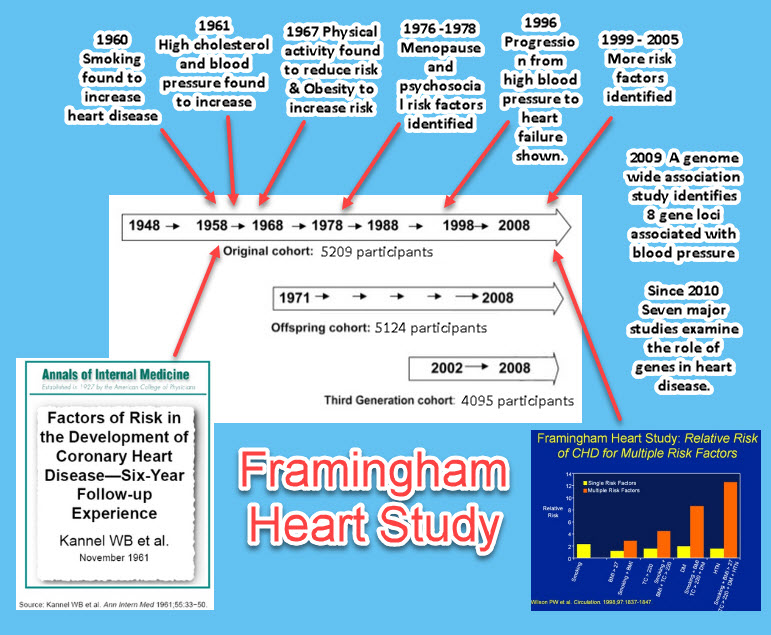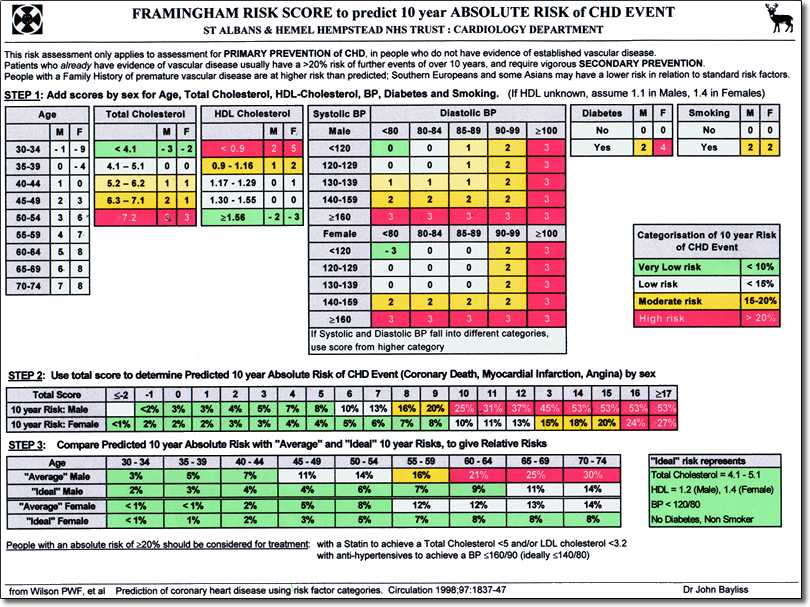Epidemiology - Framingham heart study
 The Framingham Heart Study is a long-term epidemiological study which began in 1948 and is still ongoing. This activity introduces the study with a few slides then gives students a chance to analyze the data, first simply, then with a more complex exercise using Excel. Much of our now-common knowledge about heart disease, such as the effects of diet, exercise and medications such as aspirin, is based on this study.
The Framingham Heart Study is a long-term epidemiological study which began in 1948 and is still ongoing. This activity introduces the study with a few slides then gives students a chance to analyze the data, first simply, then with a more complex exercise using Excel. Much of our now-common knowledge about heart disease, such as the effects of diet, exercise and medications such as aspirin, is based on this study.
Lesson Description
Guiding Questions
Suggest a reason for each of the findings from the Framingham Heart Study below.
High levels of HDL cholesterol reduce risk of heart disease
Cigarette smoking increases risk of heart disease.
Increased cholesterol and elevated blood pressure increase risk of heart disease.
Exercise decreases risk of heart disease, and obesity increases it.
Activity 1 - Framingham Heart study
Look at the following short news article and slides about the amazing epidemiological study, The Framingham Heart Study, then answer the questions below.
Read the Full BBC news article here and find out more about the Framingham Heart Study here.
There are sets of data from the Framingham Heart study and three other studies here.
Use the slides above to help answer the questions below.
Questions to answer
- What type of medical study is the Framingham Heart study?
................................................................................... - Give three examples of associations between risk factors and heart disease found in the Framingham study?
...................................................................................
...................................................................................
................................................................................... - Identify two factors which make this study more reliable than many other studies of the same type.
...................................................................................
................................................................................... - If you wanted to test is there was an association between the level of cholesterol in the blood and heart disease, which other variables might you control using this data?
.........................................................................................................................................................
.........................................................................................................................................................
Click the eye icon to view some suggested answers.
Suggested answers to the questions
What type of medical study is the Framingham Heart study?
It is a "cohort study" or an "epidemiological study"
Give three examples of associations between risk factors and heart disease found in the Framingham study?
Smoking is associated with a higher risk of heart disease
High Cholesterol increases risk of heart disease
Obesity is associated with a greater risk of heart disease
Physical activity is associated with a lower risk of heart disease.
Identify two factors which make this study more reliable than many other studies of the same type.
It involved a huge number of people
It has been carried out over a very long time, almost 70 years
If you wanted to test is there was an association between the level of cholesterol in the blood and heart disease, which other variables might you control using this data?
There are many other factors which could be controlled because the data contains information about the gender of the participants, their age, whether they have diabetes, or not, the BMI values, and many more.
Activity 2 - Data analysis questions about an epidemiological heart disase study
Complete this exercise on the ![]() Epidemiological data analysis. student worksheet. The analysis of this data is similar to some of the research based on the Framingham study data.
Epidemiological data analysis. student worksheet. The analysis of this data is similar to some of the research based on the Framingham study data.
Activity 3 - Analyse a part of the Framingham data yourself using Excel
This is a challenge. Excel is not really suited to analysis of such large data sets and universities often use other data analysis tools. However it is possible to complete a simple analysis to test the association between a causal fator and a health outcome like heart attack (Myocardial infarction).
Use this data ![]() Excel file of part of Framingham data set.
Excel file of part of Framingham data set.
Follow these instructions
Step by step instructions for a first analysis of the Framingham data.
- Open the online excel sheet
 Excel file of part of Framingham data set.
Excel file of part of Framingham data set. - Click on the Framingham data selection tab - to see the data
- Sort data by LDL cholesterol - lowest to highest. Us the Filter buttons on the cells in row 3
- Split the table into two groups. - find the last LDLC of 129 - then insert several rows.
Those with low LDLC - lower than 130 mg/dL
Those with high LDLC - higher than 130 mg/dL
- Count the total number of people in each group. [ =count(cell ref:cell ref)]
- Count the number of Fatal myocardial infarctions in each group (heart attacks) [ =sum(cell ref:cell ref)]
- Make a note of these numbers - Total and the number of heart attacks in each group.
- Click the Chi-squared calculator page tab, and enter the values into the table.
If the value of p >0.05 you can say there is a significant difference in the frequency of heart attacks between the two groups. I.e. that high cholesterol is associated with higher rates of heart attack
Teacher's notes
The first activity is short introduction to the purpose and usefulness of these long term cohort studies like The Framingham Heart Study, The slides aim to illustrate the usefulness and also the enormous size of the data sets which are produced.
The creation of a heart disease risk calculator is worth mentioning specifically because a tool like this is used by the researchers in the following study.
The second activity is a traditional IB style question about a study on waistline size and physical activity. Students respond to data in the worksheet to show their understanding of the data, but they will also learn about the methodology used in these studies at the same time.
The last activity is a challenging one, and it may be of interest to students who might like to do an individual investigation using some medical databases. The Framingham teaching dataset has been very simplified and the essential columns have been highlighted in yellow to help navigation. Within the Excel file there is also a sheet with a Chi-squared test calculator and another sheet which shows the data analysis analysis of the original data completed.
The NHLBI has prepared three teaching datasets suitable for use in an undergraduate or graduate level biostatistics instruction program. These datasets can be requested at no charge. Request a teaching dataset.
- A longitudinal, epidemiology focused datasets was developed using the Framingham Heart Study as the source for the data. This dataset contains three clinic examination and 20 year follow-up data on a large subset of the original Framingham cohort participants. The documentation for the Framingham dataset contains a variable list and coding help for the data.
- A clinical trial focused dataset was developed using the Digitalis Investigation Group (DIG). This dataset was designed to replicate the results found in the February 1997 NEJM article. The documentation for the DIG dataset contains a variable list and annotated forms.
- A dataset focused on longitudinal, repeated measures was developed using the Childhood Asthma Management Program (CAMP). This dataset includes 695 participants from the CAMP trial and an average of 14 spirometry measures per participant. The documentation includes a variable list, summary tables, and selected annotated form elements.
Microsoft Excel or Libreoffice Calc are very good tools for the stats required here. Sometimes students find it simpler to enter their numbers into an online tool, which can be just as good. They even offer help to interpret the calculated P values.
It's fine to use these sorts of tools in the IA, just so long as the student understands what they are doing and why.
Two examples of online Chi squared tools.
- Online chi squared calculator from Social Science stastics.
- A simpler looking online Chi squared calculater (with an option for Fisher's test) from Graphpad.
Other epidemiological studies
Busselton Health Study has been carried out since 1966 in a high proportion of the residents of Busselton, a town in Western Australia, over a period of many years. A database has been compiled and is managed by the School of Population Health at the University of Western Australia. Although the results of the Busselton Health Study and the Framingham Heart Study are similar in many aspects, the Busselton Health Study investigated also the influence of some factors that had not been not investigated in the Framingham Heart Study, e.g., sleep apnea.
The Caerphilly Heart Disease Study, also known as the Caerphilly Prospective Study (CaPS), is an epidemiological prospective cohort, set up in 1979 in a representative population sample drawn from a typical small town in South Wales, UK. The study has collected wide ranging data and has led to over 400 publications in the medical press, notably on vascular disease, cognitive function and healthy living.
China-Cornell-Oxford Project, also known as "China-Oxford-Cornell Study on dietary, lifestyle and disease mortality characteristics in 65 rural Chinese counties". This study was later referred to as "China Study I". The successor study is named "China Study II".
Public Use Datasets
Public use datasets are anonymized, freely available datasets for research purposes. Since the data is in the public domain, requirements for a research materials agreement or review by a local IRB are waived. Due to the public investment to collect and provide the data, contact information and project titles are requested for the purpose of tracking publications.National Longitudinal Mortality Study (NLMS)

 IB Docs (2) Team
IB Docs (2) Team











